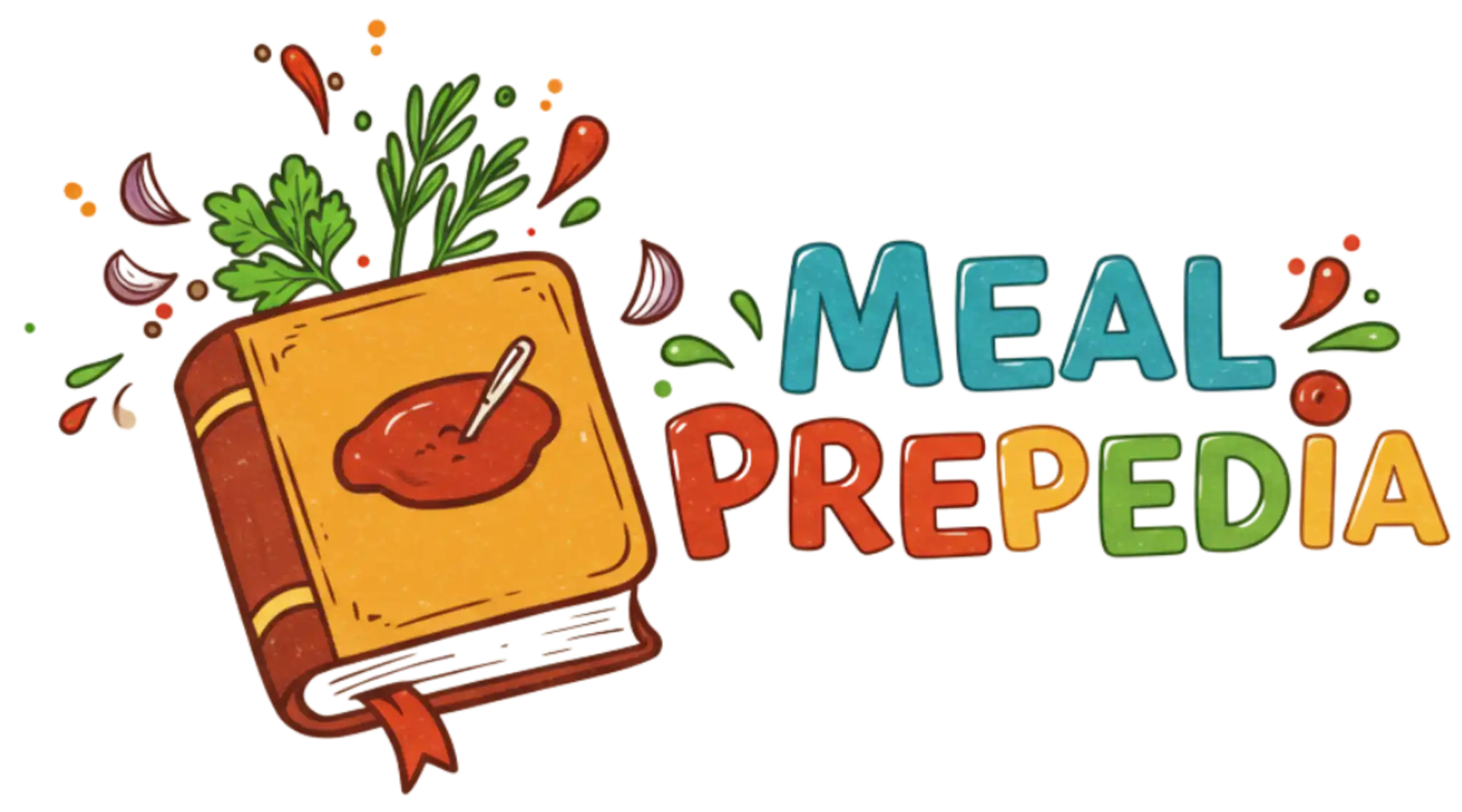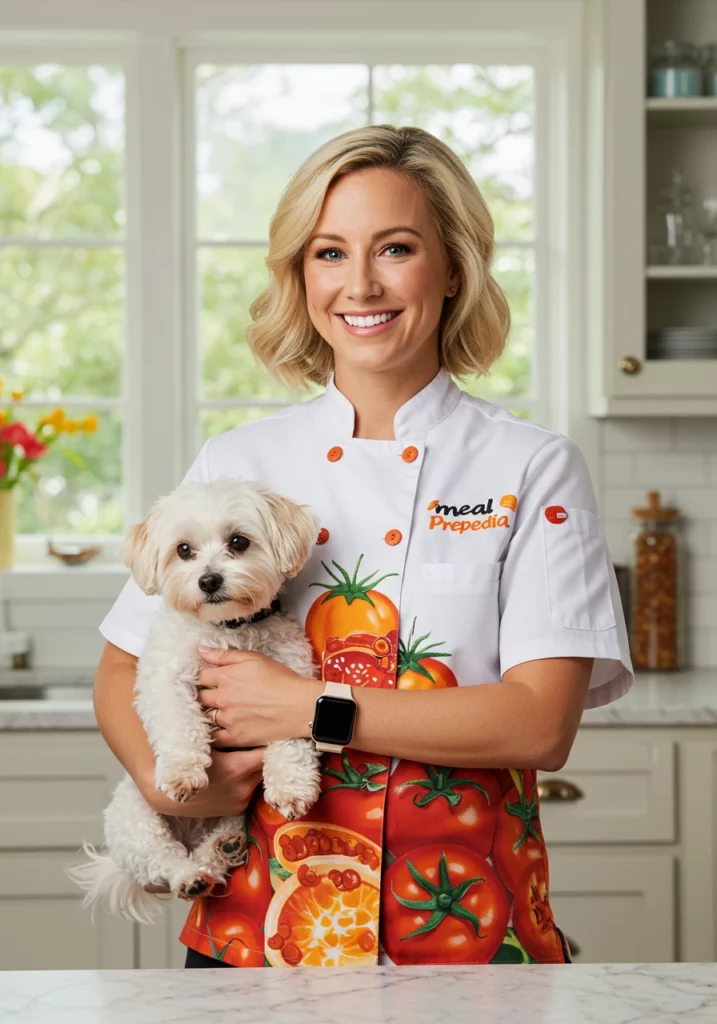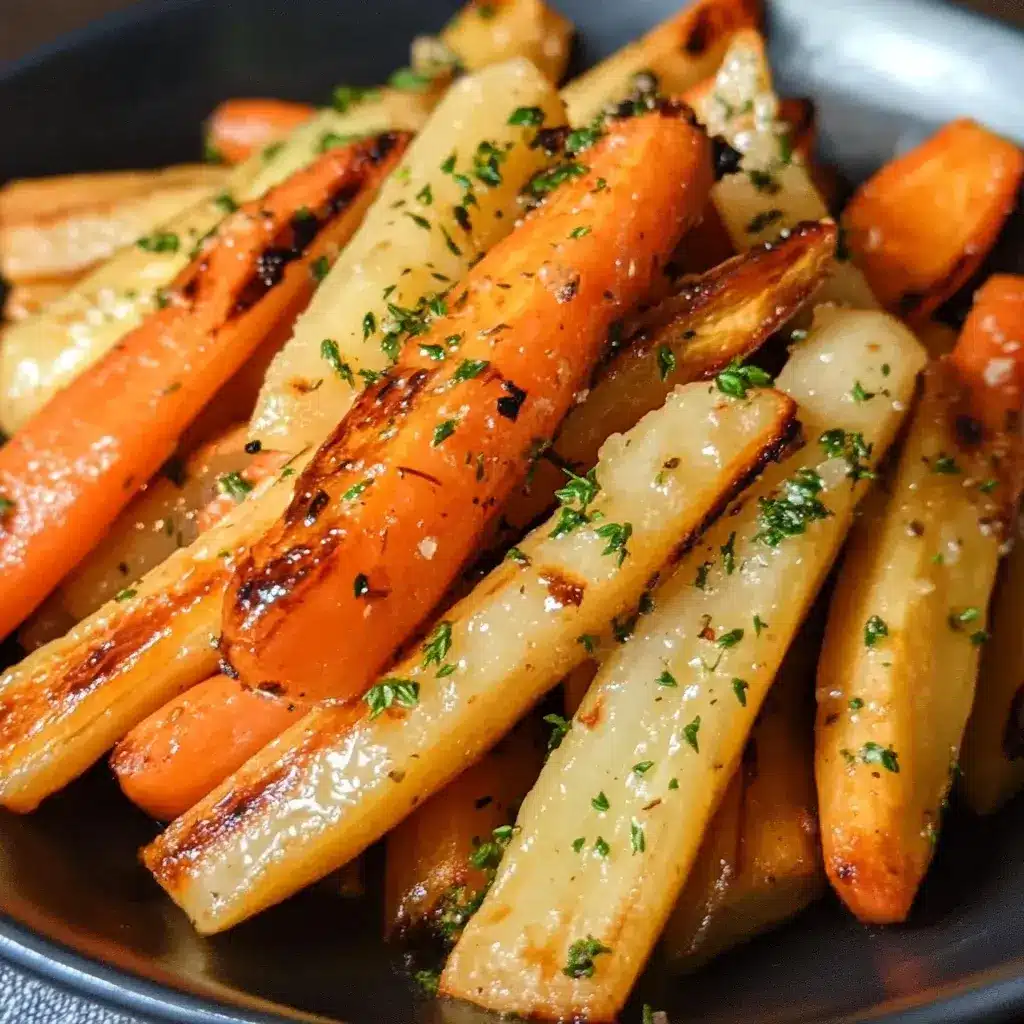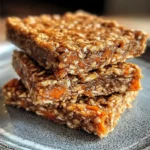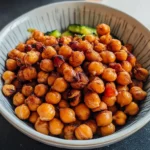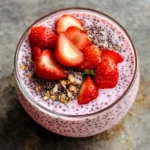It’s funny how some of the simplest recipes can become instant family favorites. Honey Glazed Carrots and Parsnips is exactly one of those dishes for us. The first time I made it, I was looking for a flavorful yet easy side to accompany a Sunday roast chicken. The combination of sweet honey, earthy root vegetables, and a hint of herbs completely transformed ordinary carrots and parsnips into something truly special. My kids, who are usually lukewarm about vegetables, devoured them, asking for seconds – a true testament to their deliciousness! Since then, these glazed beauties have become a regular feature on our table, perfect for weeknight dinners or more elaborate holiday feasts. They’re incredibly versatile, satisfying, and bring a touch of sunshine to any meal, especially during the colder months. If you’re looking for a vegetable side dish that’s both crowd-pleasing and effortlessly elegant, look no further – this Honey Glazed Carrots and Parsnips recipe is a guaranteed winner.
Ingredients
This recipe uses simple, fresh ingredients to create a dish bursting with flavor. Here’s what you’ll need:
- Carrots: 1 pound, peeled and cut into 1-inch thick batons. Choose firm, brightly colored carrots for the best flavor and texture. Baby carrots can be used in a pinch, but the flavor of full-sized carrots is superior.
- Parsnips: 1 pound, peeled and cut into 1-inch thick batons. Parsnips offer a sweet, slightly nutty flavor that complements the carrots beautifully. Look for firm parsnips without blemishes.
- Olive Oil: 2 tablespoons. Extra virgin olive oil is preferred for its flavor and health benefits. It helps to roast the vegetables perfectly and adds a subtle richness.
- Honey: 3 tablespoons. Use a good quality honey for the best glaze. Different types of honey, like wildflower or clover, will impart slightly different flavor nuances to the dish.
- Butter: 1 tablespoon, unsalted. Butter adds richness and helps to create a glossy glaze. For a vegan option, you can substitute with vegan butter or an additional tablespoon of olive oil.
- Fresh Thyme: 2 sprigs. Thyme adds a lovely herbaceous note that balances the sweetness of the honey and vegetables. Fresh thyme is recommended for its aromatic quality, but dried thyme can be substituted if necessary.
- Salt: ½ teaspoon, or to taste. Sea salt or kosher salt is preferred for seasoning. Salt enhances the flavors of all the ingredients.
- Black Pepper: ¼ teaspoon, freshly ground, or to taste. Freshly ground black pepper adds a subtle warmth and spice. Adjust to your preference.
- Optional: Fresh Parsley: For garnish, chopped. Fresh parsley adds a pop of color and freshness to the finished dish.
Instructions
Follow these simple steps to create perfectly Honey Glazed Carrots and Parsnips:
- Preheat the Oven and Prepare Vegetables: Preheat your oven to 400°F (200°C). This high temperature is ideal for roasting vegetables, allowing them to caramelize beautifully and become tender. While the oven preheats, prepare your carrots and parsnips. Wash them thoroughly, peel them using a vegetable peeler, and then trim off the ends. Cut both the carrots and parsnips into batons, approximately 1-inch thick and 2-3 inches long. Uniform size is important for even cooking. Cutting them into batons ensures they cook through at the same rate and present nicely on the plate.
- Toss Vegetables with Oil and Seasoning: In a large bowl, combine the prepared carrots and parsnips. Drizzle with olive oil. Toss the vegetables to ensure they are evenly coated with the oil. This helps them roast and prevents them from drying out. Sprinkle with salt and freshly ground black pepper. Toss again to distribute the seasoning evenly. Seasoning at this stage is crucial for flavor development.
- Roast the Vegetables: Spread the seasoned carrots and parsnips in a single layer on a large baking sheet. Ensure they are not overcrowded, as overcrowding will cause them to steam rather than roast, resulting in less caramelization and a softer texture. If needed, use two baking sheets to give them enough space. Place the baking sheet in the preheated oven and roast for 25-30 minutes, or until the vegetables are tender-crisp and lightly browned. Roasting time can vary slightly depending on oven and vegetable size, so check for tenderness by piercing with a fork.
- Prepare the Honey Glaze: While the vegetables are roasting, prepare the honey glaze. In a small saucepan, combine the honey and butter. Place the saucepan over low heat and gently melt the butter into the honey. Stir until the mixture is smooth and well combined. Heating the honey and butter together creates a luscious glaze that will coat the vegetables beautifully. Avoid boiling the glaze, as this can alter the flavor and texture of the honey.
- Glaze and Finish Roasting: After the vegetables have roasted for 25-30 minutes and are tender-crisp, remove the baking sheet from the oven. Pour the honey glaze evenly over the roasted carrots and parsnips. Toss gently to coat them thoroughly with the glaze. Return the baking sheet to the oven and continue to roast for another 5-10 minutes. This final roasting stage allows the honey glaze to caramelize further and become sticky and luscious, clinging to the vegetables. Keep a close eye on them during this stage to prevent burning.
- Add Thyme and Serve: Remove the baking sheet from the oven. Strip the leaves from the fresh thyme sprigs and sprinkle them over the glazed carrots and parsnips. Toss gently to distribute the thyme. The heat from the vegetables will release the aromatic oils from the thyme. Taste and adjust seasoning if necessary, adding a pinch more salt or pepper if needed. Garnish with fresh chopped parsley, if desired, for a pop of color and freshness. Serve immediately while warm. The honey glaze is best when freshly made and served warm.
Nutrition Facts
(Per serving, approximate, based on 6 servings. Nutritional values can vary slightly depending on ingredient brands and portion sizes.)
- Serving Size: Approximately ¾ cup
- Calories: 150
- Total Fat: 5g
- Cholesterol: 5mg
These Honey Glazed Carrots and Parsnips are a good source of fiber and vitamin A (from the carrots and parsnips), and offer a moderate amount of calories, making them a healthy and delicious side dish. They are naturally vegetarian and can be made vegan by substituting the butter with vegan butter or additional olive oil.
Preparation Time
This recipe is wonderfully simple and quick to prepare, making it perfect for busy weeknights or when you need a delicious side dish in a hurry.
- Prep Time: 15 minutes. This includes washing, peeling, and cutting the carrots and parsnips, as well as gathering and measuring the other ingredients.
- Cook Time: 30-40 minutes. This includes the initial roasting time and the final glazing and roasting time.
- Total Time: Approximately 45-55 minutes. From start to finish, you can have this flavorful side dish on your table in under an hour.
The hands-on time is minimal, allowing you to focus on other aspects of your meal while the oven does most of the work. The roasting process is relatively hands-off, requiring only a brief interruption to add the honey glaze.
How to Serve
Honey Glazed Carrots and Parsnips are incredibly versatile and can complement a wide variety of main courses. Here are some delicious serving suggestions:
- As a Side Dish for Roasts:
- Sunday Roast Chicken: The sweetness of the glaze pairs perfectly with savory roasted chicken.
- Roast Beef: The earthy sweetness of the vegetables complements the richness of roast beef.
- Roasted Turkey: An excellent side for Thanksgiving or Christmas turkey.
- Pork Loin Roast: The glaze enhances the flavors of a juicy pork loin roast.
- Alongside Vegetarian Mains:
- Lentil Loaf: Adds sweetness and color to a hearty lentil loaf.
- Vegetarian Wellington: A flavorful and colorful side for a vegetarian wellington.
- Mushroom Risotto: The sweetness of the vegetables balances the earthiness of mushroom risotto.
- Halloumi with Roasted Vegetables: Complements grilled or roasted halloumi cheese beautifully.
- For Holiday Feasts and Special Occasions:
- Thanksgiving Dinner: A classic and welcome addition to the Thanksgiving table.
- Christmas Dinner: Provides a vibrant and flavorful vegetable side for Christmas celebrations.
- Easter Brunch or Dinner: Adds a touch of spring sweetness to Easter meals.
- Potlucks and Gatherings: Travels well and is always a crowd-pleaser at potlucks.
- Tips for Serving:
- Serve Warm: Honey Glazed Carrots and Parsnips are best served warm right after roasting to enjoy their optimal texture and glaze.
- Garnish: A sprinkle of fresh parsley or thyme adds a pop of color and freshness.
- Complementary Flavors: Consider serving with other sides that offer contrasting flavors and textures, such as roasted potatoes, green beans, or a fresh salad.
- Make Ahead: While best served fresh, you can roast the vegetables ahead of time and reheat gently before glazing and serving. However, for optimal glaze texture, it’s best to glaze and roast just before serving.
Additional Tips for Perfect Honey Glazed Carrots and Parsnips
To ensure your Honey Glazed Carrots and Parsnips are a resounding success every time, here are some helpful tips:
- Choose Fresh, High-Quality Vegetables: The quality of your carrots and parsnips directly impacts the flavor of the dish. Select firm, brightly colored carrots and parsnips that are free from blemishes or soft spots. Fresh, in-season vegetables will always taste best.
- Cut Vegetables Uniformly: Cutting the carrots and parsnips into uniform batons is crucial for even cooking. Consistent size ensures that all pieces cook through at the same rate, preventing some from being overcooked while others are still undercooked.
- Don’t Overcrowd the Baking Sheet: Ensure the vegetables are spread in a single layer on the baking sheet. Overcrowding will cause them to steam rather than roast, resulting in soggy vegetables instead of beautifully caramelized ones. Use two baking sheets if necessary to give them enough space.
- Roast at the Right Temperature: 400°F (200°C) is the ideal temperature for roasting these root vegetables. This high heat allows them to caramelize on the outside while becoming tender on the inside. Make sure your oven is properly preheated before placing the vegetables inside.
- Adjust Glaze Sweetness to Taste: Honey provides a natural sweetness, but you can adjust the amount to your preference. If you prefer a less sweet glaze, start with 2 tablespoons of honey and taste before adding more. You can also use maple syrup or agave nectar as alternatives to honey for a slightly different flavor profile.
- Add a Touch of Spice: For a hint of warmth and complexity, consider adding a pinch of ground cinnamon, nutmeg, or ginger to the honey glaze. These spices complement the sweetness of the honey and the earthiness of the root vegetables beautifully.
- Experiment with Herbs: While thyme is a classic pairing, feel free to experiment with other fresh herbs like rosemary, sage, or oregano. Each herb will impart a unique flavor dimension to the dish. You can also use a combination of herbs for a more complex flavor.
- Make it Vegan: To make this recipe vegan, simply substitute the butter in the honey glaze with vegan butter or an additional tablespoon of olive oil. The flavor and texture will remain delicious and satisfying.
Frequently Asked Questions (FAQ)
Here are some common questions about making Honey Glazed Carrots and Parsnips:
Q1: Can I use baby carrots for this recipe?
A: Yes, you can use baby carrots if you are short on time or prefer their convenience. However, keep in mind that baby carrots may not have the same depth of flavor as full-sized carrots. If using baby carrots, you may need to reduce the roasting time slightly as they tend to cook faster.
Q2: Can I make this recipe ahead of time?
A: While Honey Glazed Carrots and Parsnips are best served fresh, you can prepare the vegetables ahead of time by peeling and cutting them. Store them in an airtight container in the refrigerator for up to 24 hours. You can also roast the vegetables ahead of time and reheat them gently before glazing and serving. However, for the best glaze texture, it’s recommended to glaze and roast them just before serving.
Q3: Can I freeze Honey Glazed Carrots and Parsnips?
A: Freezing roasted vegetables is not generally recommended as their texture can become mushy upon thawing. It’s best to enjoy this dish fresh for the best quality.
Q4: What can I substitute for fresh thyme?
A: If you don’t have fresh thyme, you can substitute it with dried thyme. Use about 1 teaspoon of dried thyme for 2 sprigs of fresh thyme. You can also use other dried herbs like rosemary or sage, or a mixed Italian herb blend.
Q5: Can I use a different type of honey?
A: Yes, you can use different types of honey for this recipe. Clover honey, wildflower honey, or even buckwheat honey will all work well, each imparting a slightly different flavor nuance. Consider the flavor profile of the honey you choose and how it will complement the vegetables.
Q6: How do I prevent the honey glaze from burning?
A: To prevent the honey glaze from burning, keep a close eye on the vegetables during the final roasting stage after adding the glaze. Reduce the oven temperature slightly if you notice the glaze browning too quickly. Roasting for a shorter time at the glazing stage can also help.
Q7: Can I add other vegetables to this recipe?
A: Yes, you can certainly add other root vegetables to this recipe. Consider adding sweet potatoes, butternut squash, or rutabaga. Adjust the roasting time as needed depending on the density of the vegetables you add.
Q8: Is this recipe gluten-free and vegetarian/vegan?
A: Yes, this recipe is naturally gluten-free and vegetarian. To make it vegan, simply substitute the butter in the honey glaze with vegan butter or an additional tablespoon of olive oil. Always double-check the labels of your ingredients to ensure they are gluten-free and vegan if needed for dietary restrictions.
Print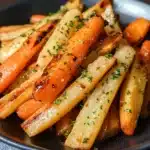
Honey Glazed Carrots & Parsnips
Ingredients
This recipe uses simple, fresh ingredients to create a dish bursting with flavor. Here’s what you’ll need:
- Carrots: 1 pound, peeled and cut into 1-inch thick batons. Choose firm, brightly colored carrots for the best flavor and texture. Baby carrots can be used in a pinch, but the flavor of full-sized carrots is superior.
- Parsnips: 1 pound, peeled and cut into 1-inch thick batons. Parsnips offer a sweet, slightly nutty flavor that complements the carrots beautifully. Look for firm parsnips without blemishes.
- Olive Oil: 2 tablespoons. Extra virgin olive oil is preferred for its flavor and health benefits. It helps to roast the vegetables perfectly and adds a subtle richness.
- Honey: 3 tablespoons. Use a good quality honey for the best glaze. Different types of honey, like wildflower or clover, will impart slightly different flavor nuances to the dish.
- Butter: 1 tablespoon, unsalted. Butter adds richness and helps to create a glossy glaze. For a vegan option, you can substitute with vegan butter or an additional tablespoon of olive oil.
- Fresh Thyme: 2 sprigs. Thyme adds a lovely herbaceous note that balances the sweetness of the honey and vegetables. Fresh thyme is recommended for its aromatic quality, but dried thyme can be substituted if necessary.
- Salt: ½ teaspoon, or to taste. Sea salt or kosher salt is preferred for seasoning. Salt enhances the flavors of all the ingredients.
- Black Pepper: ¼ teaspoon, freshly ground, or to taste. Freshly ground black pepper adds a subtle warmth and spice. Adjust to your preference.
- Optional: Fresh Parsley: For garnish, chopped. Fresh parsley adds a pop of color and freshness to the finished dish.
Instructions
Follow these simple steps to create perfectly Honey Glazed Carrots and Parsnips:
- Preheat the Oven and Prepare Vegetables: Preheat your oven to 400°F (200°C). This high temperature is ideal for roasting vegetables, allowing them to caramelize beautifully and become tender. While the oven preheats, prepare your carrots and parsnips. Wash them thoroughly, peel them using a vegetable peeler, and then trim off the ends. Cut both the carrots and parsnips into batons, approximately 1-inch thick and 2-3 inches long. Uniform size is important for even cooking. Cutting them into batons ensures they cook through at the same rate and present nicely on the plate.
- Toss Vegetables with Oil and Seasoning: In a large bowl, combine the prepared carrots and parsnips. Drizzle with olive oil. Toss the vegetables to ensure they are evenly coated with the oil. This helps them roast and prevents them from drying out. Sprinkle with salt and freshly ground black pepper. Toss again to distribute the seasoning evenly. Seasoning at this stage is crucial for flavor development.
- Roast the Vegetables: Spread the seasoned carrots and parsnips in a single layer on a large baking sheet. Ensure they are not overcrowded, as overcrowding will cause them to steam rather than roast, resulting in less caramelization and a softer texture. If needed, use two baking sheets to give them enough space. Place the baking sheet in the preheated oven and roast for 25-30 minutes, or until the vegetables are tender-crisp and lightly browned. Roasting time can vary slightly depending on oven and vegetable size, so check for tenderness by piercing with a fork.
- Prepare the Honey Glaze: While the vegetables are roasting, prepare the honey glaze. In a small saucepan, combine the honey and butter. Place the saucepan over low heat and gently melt the butter into the honey. Stir until the mixture is smooth and well combined. Heating the honey and butter together creates a luscious glaze that will coat the vegetables beautifully. Avoid boiling the glaze, as this can alter the flavor and texture of the honey.
- Glaze and Finish Roasting: After the vegetables have roasted for 25-30 minutes and are tender-crisp, remove the baking sheet from the oven. Pour the honey glaze evenly over the roasted carrots and parsnips. Toss gently to coat them thoroughly with the glaze. Return the baking sheet to the oven and continue to roast for another 5-10 minutes. This final roasting stage allows the honey glaze to caramelize further and become sticky and luscious, clinging to the vegetables. Keep a close eye on them during this stage to prevent burning.
- Add Thyme and Serve: Remove the baking sheet from the oven. Strip the leaves from the fresh thyme sprigs and sprinkle them over the glazed carrots and parsnips. Toss gently to distribute the thyme. The heat from the vegetables will release the aromatic oils from the thyme. Taste and adjust seasoning if necessary, adding a pinch more salt or pepper if needed. Garnish with fresh chopped parsley, if desired, for a pop of color and freshness. Serve immediately while warm. The honey glaze is best when freshly made and served warm.
Nutrition
- Serving Size: one normal portion
- Calories: 150
- Fat: 5g
- Cholesterol: 5mg
